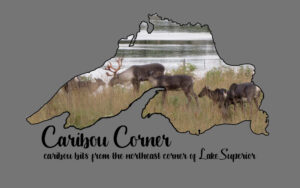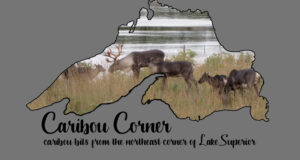 The ancestors of caribou (or reindeer as they are known in Eurasia) moved out of South America about 5 million years ago. Caribou appear to have speciated in Beringia, which is the name for the far northwest part of North America and the far northeast of Russia, next to the Bering Sea. This occurred during the Pleistocene epoch, or the Ice Age as it is commonly known, about 2,580,000 years ago to just 11,700 years ago. The earliest known caribou fossil is from Alaska and is about 1.8 million years old. Caribou would have been around for a while before that – so from maybe 2 million years ago. By contrast, early humans emerged only about 300,000 years ago.
The ancestors of caribou (or reindeer as they are known in Eurasia) moved out of South America about 5 million years ago. Caribou appear to have speciated in Beringia, which is the name for the far northwest part of North America and the far northeast of Russia, next to the Bering Sea. This occurred during the Pleistocene epoch, or the Ice Age as it is commonly known, about 2,580,000 years ago to just 11,700 years ago. The earliest known caribou fossil is from Alaska and is about 1.8 million years old. Caribou would have been around for a while before that – so from maybe 2 million years ago. By contrast, early humans emerged only about 300,000 years ago.
Caribou survived several glacial advances and retreats of the Pleistocene. But it is the last advance, called the Wisconsin glaciation, that we know a bit more about in relation to caribou. The Wisconsin glaciation occurred from about 75,000 to about 11,000 years ago, and reached its maximum about 25,000 to 21,000 years ago. The advancing ice moved caribou into two main refuges in North America. One refuge was in Beringia, in the northwest, where the caribou first evolved. It appears that this is where the ancestors of the barren-ground caribou and many of the mountain caribou were. Another refuge was in the Appalachian Mountains of what is now the eastern United States. It is here that the woodland caribou were. These were the ancestors of the few remaining Lake Superior caribou.
This refuge in the Appalachians had interesting characteristics that allowed caribou to survive south of the ice sheet. Back then, the mountains there were mainly forested with jack pine and spruce and many had bare tundra tops – quite a bit different than the lush nut-producing hardwoods there now. So the mountains would have been very good caribou habitat at that time, with lots of ground and tree lichens. The animal community also seems to have been important. The other main herbivores in the mountains were pig-like peccaries and tapirs, which were a bit smaller and more abundant than the caribou. They may have diverted predation away from the caribou.
Even more interesting is the spatial separation from the large numbers of other Pleistocene mammals that occupied the flatter terrain to the west of the Appalachians. This area to the west had abundant very large mammals like mammoths (up to 7300 kg, or 8 tons), mastodons (to 5400 kg, a puny 6 tons), ground sloths (to 1400 kg, the weight of a car), stag moose (to over 700 kg, our moose get to about 500 kg), woodland muskox (to over 400 kg), and giant beavers (to 125 kg, our beavers average 20 kg). These herbivores supported very large predators like short-faced bears (up to 800 kg, black bears are usually less than 250 kg), sabre toothed cats (to 280 kg), and dire and gray wolves (to 80 kg). These predators would make short work of the relatively small caribou (up to 150 kg). It is thought that the caribou separated themselves from these other Pleistocene herbivores and their predators to avoid predation. To this day caribou still use this strategy of separation to avoid the larger number of wolves and bears in areas with more moose and deer.
At the end of the Ice Age about 10,000 to 12,000 years ago, most of the large Pleistocene herbivores and their predators went extinct. The causes of these extinctions are not clear, but may be related to overhunting of both the herbivores and their predators by the first humans moving into the area. This also resulted in changes in habitat, and there was some climate change thrown in. Caribou may have benefited from the loss of these large herbivores and their predators, and were then able to move out of the Appalachians and all along the forest edge following the retreating ice across the continent.
The ice left the north shore of Lake Superior about 10,000 years ago. The area was actually reforested quite quickly after the glaciers left, so caribou would probably have been north of the lake at least 9000 years ago, and earlier along the south shore.
As the ice receded, the caribou would also have been accompanied by the first humans moving into the Lake Superior area. Caribou were very important to these people for food, hides, and tools. Yet caribou and people lived successfully together in this area for the next few thousand years.
Then, less than 200 years ago, things started to change – and not for the better. Today there are hardly any caribou left in the Lake Superior area, and we are about to lose the last few on the mainland there.
In summary: From their start about 2 million years ago, caribou have survived the many glacial advances of the Ice Age, the Pleistocene large mammal extinction, and the first human invasion of North America.
Coming up next: The recent history of the Lake Superior caribou and why there are so few left.
If you would like to know more about the Lake Superior caribou and how to save the last of the mainland caribou there, see www.lakesuperiorcaribou.ca
Your caribou stories and sightings are also welcome – no matter how old or young.
- Hydro One reçoit l’autorisation de devenir le fournisseur d’électricité local de la communauté de Chapleau - April 19, 2024
- Hydro One receives approval to join the Chapleau community as the local electricity supplier - April 19, 2024
- L’artiste innu Scott-Pien Picard anime un spectacle pour des élèves de l’ÉSC Trillium et de l’ÉS Saint-Joseph - April 19, 2024
 Wawa-news.com You can't hear the 'big picture'!
Wawa-news.com You can't hear the 'big picture'!
